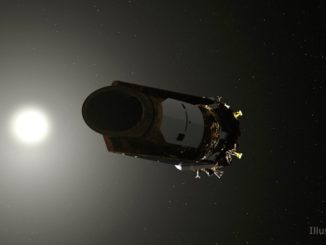
Internet investor Yuri Milner yesterday announced the Breakthrough Listen project with Stephen Hawking, Martin Rees, Frank Drake, Ann Druyan and Geoff Marcy at The Royal Society in London, a $100 million Breakthrough Prize Initiative to dramatically reinvigorate the search for intelligent life in the universe over the next ten years. This is the biggest scientific search yet for signs of intelligent life beyond Earth.
Lick Observatory’s Automated Planet Finder (APF) Telescope above San Jose, California, will undertake a new deep and broad search for optical laser transmissions from nearby civilisations, if any exist.
The APF is the newest telescope at Lick Observatory. It consists of a 2.4-metre automated telescope and enclosure, and the high-resolution Levy spectrograph. It operates robotically on every clear night of the year; its main emphasis to date has been on discovering and characterising extrasolar planets.

With this new Breakthrough Prize Initiative, the APF telescope and its Levy spectrometer will search 1,000 nearby stars and 100 nearby galaxies for visible-light laser emission from technological sources. Lasers may be used by other civilisations for communication between their home planet and satellites, interplanetary spacecraft, or colonies on other worlds.
Such laser emissions will be distinguished from the emission from astronomical objects by the extreme single-wavelength nature of laser emission, and by the unresolved point source (a dot in the sky) from which the emission originates. It may even be that the Milky Way contains a galactic internet of laser emission. If so, the APF may be able to eavesdrop on their transmissions.
“As part of the Breakthrough Prize Initiative, the APF telescope will undertake the most extensive search for optical laser transmissions in history,” said Claire Max, Interim Director of UC Observatories. It is a tremendous honour to participate in a project of this size and scope.”

The initiative was announced 20 July at The Royal Society in London. The Breakthrough Prize Foundation is also contracting with two of the world’s largest radio telescopes for the search — the 100-metre Robert C. Byrd Green Bank Telescope in West Virginia and the 64-metre Parkes Telescope in New South Wales, Australia.
“We’ve learned a lot in the last fifty years about how to look for signals from space. With the Breakthrough Initiatives, the learning curve is likely to bend up-ward significantly,” said Frank Drake, SETI pioneer and UCSC Professor Emeritus in Astronomy and Astrophysics. “Right now there could be messages from the stars flying right through the room, through us all. That still sends a shiver down my spine. The search for intelligent life is a great adventure.”
The overall program will include a survey of the 1,000,000 closest stars to Earth. It will scan the centre of our galaxy and the galactic plane. Beyond the Milky Way galaxy, telescopes will listen for messages from the 100 closest galaxies.
“We learned from the NASA Kepler mission that our Milky Way Galaxy contains tens of billions of Earth-size planets at lukewarm temperatures, any of which might harbuor life,” said Geoff Marcy, Professor of Astronomy and Astrophysics at UC Berkeley.
Other project leaders include Dan Wertheimer (SETI), Andrew Siemion (Berkeley SETI Research Center), Lord Martin Rees (University of Cambridge), Pete Worden (Breakthrough Prize Foundation) and Ann Druyan (Cosmos Studios).



